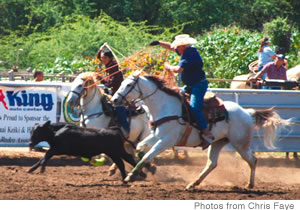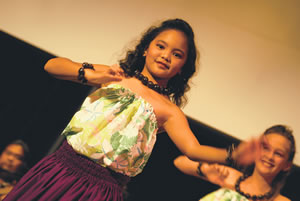West Side Glory

Crowds show up for live entertainment and food
Waimea is the place to be this week for the Waimea Heritage Days, organized by Thomas Nizo (inset, with Sherri Patrick), followed by the Waimea Town Celebration, in which Chris Faye is again involved
Celebrate the West side’s plantation legacy while having a ton of fun at two different events this week
It’s all about Waimea this week, true to the plantation roots that have come to be known as the most salient and recognizable features of Kaua’i’s West side.
It’s the week of Waimea Heritage Days and the Waimea Town Celebration, both part of an evolving, burgeoning tradition thanks to volunteers and West side staples Thomas Nizo and Chris Faye, among others.
Nizo, who started Waimea Heritage Days three years ago, says the series of events are aimed at capturing the essence of what he remembers from his plantation childhood and sharing it with the rest of Kaua’i, as well as visitors to the Island. Nizo, the fourth generation of his family to be living in a plantation camp, says he wants to share the strong sense of place that kind of lifestyle instills.

Thomas Nizo and Sherri Patrick at Waimea Theater, which hosts a film festival
“I grew up during a time when the Kekaha and Olokele sugar mills were in full operation,” he says. “My great-grandparents, grandparents and parents were all employed by the Gay and Robinson Sugar Company,” Nizo says, noting the plantation lifestyle provided him not only with his education and sustenance, but what he describes as a strong, intertwined community. “Japanese, Chinese, Korean, Portuguese, Filipino and Hawaiian neighbors provided great examples of strong work ethics as well as their own traditions,” he says, referencing what would later contribute to an emerging plantation culture.
Japanese culture played a key role for Nizo, too, as his family benefited from the tradition of tanimoshi, the pooling of money among friends so loans could be made to those who needed it most.
But perhaps what he remembers most fondly is a tradition called “pau harvest” during the wet season – when the plantation would give workers time off to prepare food for a party for the entire camp.
Several cultures coming together helped inspire Nizo to offer activities for the older generation to relive times gone by, coupled with an opportunity to educate youths on this type of experience.
“I want the younger generation to experience traditions and cultural diversity,” Nizo says, describing the reason he wanted to create Waimea Heritage Days, four nights of “cultural sharing” at historic Waimea Theater, where he is manager.
A festival of sorts, the four-day series of events precedes the Waimea Town Celebration.
“I wanted to provide more events on the West side,” he says. “Growing up we had a lot of events to go to through the plantation. I wanted to provide more opportunities for people to come to the West side.”

Chris Faye is a fourth-generation West-sider
Whereas the Waimea Town Celebration offers lots of food booths and entertainment as well as the opportunity for schools and different organizations to raise funds, Nizo says Heritage Days offers evening activities that are more about celebrating the quieter, family aspect of plantation life and bringing that to the spotlight for everyone from keiki to kupuna.
It’s with a certain sense of nostalgia and appreciation for the West side’s unique attributes that Chris Faye, who heads the public relations for the Waimea Town Celebration, has been handling the event for years.
Faye, who is probably better known for her family history, is all about Island history in general. The curator at Kaua’i Museum also is an artist, though she prefers to keep her work for the Waimea Town Celebration separate from her professional life.
Faye’s great-grandfather, Hans Peter Faye, came from Norway to join his Uncle Valdemar Knudsen in the growing sugar industry in 1880. The historic Waimea Plantation Cottages were initially built in the late 1800s to house those sugar plantation workers and overseers as part of Kekaha Sugar Co.
“To his misfortune, (Hans Peter Faye’s) uncle and family had left the Island on an extended vacation and he had to learn his trade where he could until they returned,” Chris Faye says.

Scotty Shapiro (center) with Glinburn Lorenzo and Lyn Garcia. Scotty’s Music is sponsoring an ukulele festival
Hans Peter Faye joined his sister and brother-in-law on Maui for a couple of years and then came back to Kaua’i and grew sugar in Hanapepe for Gay and Robinson, and realized he would make a better living working for himself. In 1884, his uncle returned and leased some poor land at Mana. “With hard work and perseverance, he made the land pay with the help of the Hawaiians and area Chinese rice farmers, along with a stake of money from Paul Isenberg,” Chris Faye adds.
In 1898, Hans Peter Faye and all the sugar interests from Kekaha to Mana formed Kekaha Sugar Co., becoming its first manager. (Chris Faye’s grandfather Lindsay and father Tony also were managers there.)
So it makes sense that Chris Faye is still part of keeping alive the historic aspects of the West side, not only because of a vested interest as one of the owners of the Waimea Plantation Cottages, but because of a love for what she describes as a “fun community event from the plantation culture we grew up in.”
She says what makes the West side so unique when compared to the rest of the island is that it’s made up of not only plantation communities, but that it once had the heaviest concentration of population because of the great river valleys that provided water for kalo, and later for rice and sugar.
“Plantation communities were company towns centered on a dominant industry which provided for its labor housing, health care, recreation and more,” Faye says. “It was an environment where neighbors and the company cared for the welfare of all. There is still a strong sense of community and caring for the success of the community as a whole – of everyone pitching in when necessary.”
It’s that ‘ohana mindset that likely makes Waimea Town Celebration so well loved, along with that sense of nostalgia.

Rodeo action is part of the fun
For Faye, childhood memories include summer visits to her grandparents at their family homes in Koke’e and Hanalei, and also staying in what is commonly referred to as the “Director’s Cottage” next door to her Uncle Alan and Aunt Jean’s house (aka the Manager’s House) at Waimea Plantation Cottages.
“I remember fondly the screened lanai and eating Pirie mangos that you could twist off the seed,” she says. “There were the dairy herd and Shetland ponies. It must have been a visit for just a day or two, but the memories are vivid.”
Faye has been involved as a volunteer public relations coordinator for the Waimea Town Celebration since 1996, and says she is happy to be part of what now marks the event’s 34th year running – literally. “It started as a carbo-loading party for the Captain Cook Caper (Fun Run) in 1978, during the Captain Cook bicentennial,”
Faye says, noting that this year people can look forward to a familiar gamut of events, including the Captain Cook Caper 2K, 5K and 10K fun run, an all-out rodeo, basketball tournament, and ukulele and hat lei competitions.
Scotty Shapiro, owner of Scotty’s Music, has been sponsoring the ukuele competition (which he prefers to call an ukulele festival, as there are “no losers, only winners”) for the past five years, and says he got involved after realizing it would be an opportunity to give back to a community he loves.
“I thought it’d be an exceptional benefit for me to help the community and so many people on the island who have come to me and given to me,” Shapiro says.
“I felt it’s very fortunate for me to have the opportunity to show my gratitude. It’s just very meaningful to me. I love to see the passion that people put into their performances.”
Of course, there’s also the traditional local fare, which no doubt brings out return attendees in droves.
“There’s the Methodist Church’s famous malasadas, Hawaiian plates, and all the local favorites – teri chicken, caesar salad, taco salads, hamburgers and flying saucers,” she says, noting this year there will be local fruit juices in addition to soda, and a beer garden “if you’re old enough.”

Hula is part of the cultural celebration
Of course, people such as county anti-drug coordinator Theresa Koki, who also hails from a West side plantation family, hope this year people will drink responsibly.
“Traditions are huge on the West side, and we continue to honor that,” Koki says. “(But) some, not all, have adopted drinking alcohol as part of a Waimea Town Celebration tradition. It is our hope that the community can rally together, in the spirit of tradition, to remind each other that the real celebration is found when people of a close-knit community can enjoy each others’company in an environment that is safe and fun-filled for all.”
As for what the Waimea Town Celebration promises to bring those in search of tradition, Faye says what makes the West side special is that it has persisted in retaining and protecting its unique aspects, and that it has a strong sense of community and volunteerism.
“(It has a) togetherness of the community while honoring the culture and history that went before,” Faye says. “We work together to retain the old-time closeness of the town.”
She says she hopes the growing tradition that has become a household name across the island will help enable her to later pass the torch:
“We have many volunteers, and we hope that new and younger volunteers will come forward to continue creating an opportunity for the community to come together, work together and have a good time, while earning money to support all the not-for-profit activities that assist us in making the community special and successful.”



